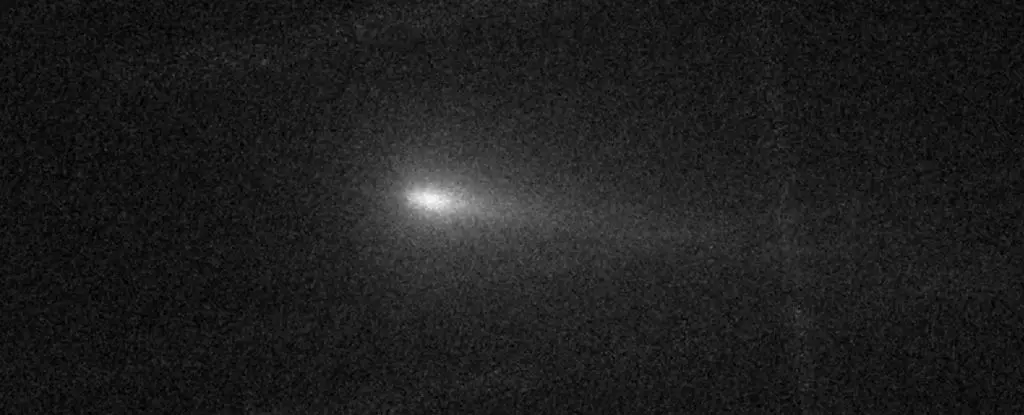The anticipation surrounding notable astronomical events often fuels excitement among skywatchers, scientists, and enthusiasts alike. One of the most recent letdowns is the comet C/2024 S1, which was heralded as a potentially stunning light show this Halloween. However, as fate would have it, this comet seems to be facing a rather unfortunate fate—disintegration. The story of C/2024 S1 is not merely one of a bright celestial body approaching its climax, but rather a poignant reminder of the unpredictable nature of comets and the fleeting moments of wonder they offer.
Discovered on September 27, C/2024 S1 is classified as a Kreutz sungrazer comet. These comets have notoriously dramatic orbits that take them perilously close to the Sun—within a mere 1.2 million kilometers (750,000 miles) on October 28, 2024, in this case. Such encounters with our solar behemoth often lead to spectacular outcomes, either through intense brightness visible to the naked eye or disintegration, caused by the Sun’s overpowering gravitational and thermal influence. As it appears now, the latter is transpiring.
Initial images captured through October hinted at the potential of the comet, showcasing an increase in brightness and what seemed to be eruptions of activity. However, as the days passed, the comet began to dim, its nucleus fading into obscurity. The transient beauty of comets is part of their allure; however, C/2024 S1 has left many with a sense of melancholy as it appears to succumb to the very forces that gave it life.
The Mechanics Behind Disintegration
Comets are enigmatic beings made predominantly of ice and dust, formed in the icy, distant fringes of our Solar System. When they venture closer to the Sun, the sublime art of sublimation occurs; ice transforms into gas, and pressure builds within the comet. This rapid process can induce instability, leading to drastic changes such as outbursts, fragmentation, or complete disintegration. C/2024 S1 seems to be experiencing these phenomena.
The Hubble Space Telescope has provided valuable insights into similar events. In 2020, Comet C/2019 Y4 was observed fragmenting near the Sun, providing astronomers with a rare view of a comet’s demise. While C/2024 S1 has shown signs of instability, including at least one significant outburst, the full extent of its disintegration became evident around October 20 and 22, as documented by amateur astronomer Martin Mašek from Czechia. The fading visibility of the comet’s nucleus has sparked concerns over the potential loss of its majestic presence in the night sky.
The Aftermath: What’s Next for C/2024 S1?
The initial predictions painted an optimistic picture, suggesting that C/2024 S1 could become brighter than Venus and possibly visible in daylight. However, these hopes seem curtailed as the comet continues to fade. While a fraction of its nucleus may survive the ongoing fragmentation, which would still yield a spectacular tail, the likelihood of witnessing a grand celestial display as anticipated seems to dwindle.
It’s intriguing to note that C/2024 S1 is believed to be a remnant of a larger comet, specifically the Great Comet of 1106 CE, which fragmented into several smaller bodies over the centuries. This history adds another layer to the comet’s narrative; remnants of a cosmic journey that began over a millennium ago. Skywatchers might still catch glimpses of the comet, particularly in the Southern Hemisphere, armed with binoculars or telescopes, but the thrill of seeing its nucleus may be a wish unmet.
Comets serve as fascinating harbingers of cosmic beauty and unpredictability—elements that are embedded in their very nature. C/2024 S1’s journey not only signifies the ephemeral nature of such celestial visitors but emphasizes the role of observational limitations and scientific forecasting. Each encounter with a comet serves as a reminder that, while many predictions can be made, the vastness of the universe carries a myriad of uncertainties.
The disintegration of C/2024 S1 is a mixture of disappointment and awe—an acknowledgment of both the wonders and the unpredictability of the universe. While it may not deliver the grand spectacle expected, the comet’s fleeting existence inspires curiosity and reminds us of the delicate balance between expectation and reality in our pursuit of the stars. As we await further developments on this cosmic traveler, we foster a sense of hope, ready for new celestial wonders that lie beyond the horizon. Happy hunting to all, and may the night sky continue to inspire awe and wonder!

